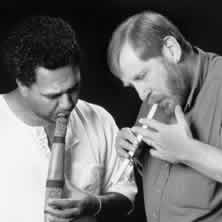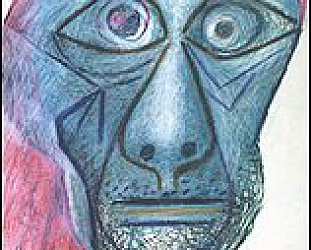Graham Reid | | 4 min read
Richard Nunns and Hirini Melbourne: Te Auraki A Taane

The late Hirini Melbourne, who died of cancer in January '03 aged 53, opened a window on the past which has allowed others to see a future. Through his work with fellow musicologist Richard Nunns, Melbourne -- of Tuhoe and Ngati Kahungunu descent -- brought traditional Maori instruments back into the spotlight through performance, teaching and recording.
His legacy is too vast to conveniently encapsulate.
But a CD with accompanying DVD of discussions and performances, recorded in the final weeks of his life, will open that window wider to allow contemporary musicians and traditionalists another, even brighter view.
The album Te Hekenga-a-rangi incorporates taonga pouro (traditional Maori instruments) such as koauau (nose flute), putatara (conch) and pukaea (trumpet), but also takes a contemporary slant by using the voice of Aroha Yates-Smith, dean of the department of Maori and Pacific Studies at the University of Waikato.
 The result is a package of music and
performances, beautifully realised by producer Steve Garden and
director Keith Hill, that is a leap forward from Melbourne and Nunns'
1994 album Te Ku Te Whe, which was greatly influential in giving
voice again to the old instruments.
The result is a package of music and
performances, beautifully realised by producer Steve Garden and
director Keith Hill, that is a leap forward from Melbourne and Nunns'
1994 album Te Ku Te Whe, which was greatly influential in giving
voice again to the old instruments.
That spare and earthy album inspired Moana to use the sounds of taonga pouro on her debut album with the Moa Hunters, Tahi, and the sound of koauau infiltrated soundtracks on films such as Once Were Warriors and Maori television productions.
But while the gold-selling Te Ku Te Whe -- recorded and mixed in three days -- was austere and deliberately minimal, this long overdue follow-up extends the contract of Melbourne and Nunns' investigations into a deftly textured, thematic album which uses subtle layering of the sounds in the studio and invokes atua wahine (female deities).
It is not a traditional album although it uses traditional instruments and incorporates mythological themes and characters. It also includes non-traditional sounds from discreetly bowed guitar and percussive sounds from a shotgun shell.
It is an intensely spiritual album and the title refers to an ancient people said to have originated in the heavens who then occupied Aotearoa. Their spirit is in the shells and stones -- and in these seamlessly melded evocative songs and inventive sonic structures.
"It was a natural progression," says Nunns, a research assistant at the University of Waikato who has performed with Moana, English avant-garde saxophonist Evan Parker, classical flautist Alexa Still and with Melbourne at the opening of Te Papa.
 "Te Ku Te Whe was a reasonably
accurate reflection of where we were at the time it was made. But
there were eight or nine years between that and this and we've
developed and grown, and worked on a wider range of instruments.
"Te Ku Te Whe was a reasonably
accurate reflection of where we were at the time it was made. But
there were eight or nine years between that and this and we've
developed and grown, and worked on a wider range of instruments.
"Hirini in particular became interested in their layering and weaving within the studio and with the technical facilities we had. In terms of his last wishes to Steve, the ultra-spacey things were very much what he wanted.
"We also recognised the one major missing component of Te Ku Te Whe was the female essence, and Aroha not only sings in a beautiful way, but also brings scholarship and a profound knowledge of female spirituality and goddesses, her doctorate was in that area.
So she made a major contribution to the
thematic, vocal and linguistic concerns."
Melbourne was diagnosed with cancer in
January '02 and Nunns said they lived with that knowledge, and his
increasing illness, all of the year.
However, the multimedia company Rattle, which had produced Te Ku Te Whe, offered an anytime-anywhere option of recording again. Late in the year Melbourne was feeling slightly better, so a studio at the University of Waikato was booked for five days in December and Melbourne made what Garden calls "a heroic effort".
Melbourne came in, as before, with just some fragments of text. Over the days they explored musical and spiritual ideas together and Nunns describes the process as "organic".
Nunns: "He was very sick but came in with bright eyes sparkling with intensity, but moving very slow. You can hear it and a lot of people, especially friends and relations, will be distressed initially at the sound of his voice. It's nearly not there, it is definitely a man dying.
"But it is also an artefact now and a document. Rattle have done us proud and the DVD is wonderful to look at."
 Through discussion of their exploration
of the stories of taonga pouro, performance and demonstrations of the
instruments, the DVD is as profound and moving as the CD. By not
having published scholarly dissertations about the instruments and
the way they may have been played, there was some controversy a
decade ago about whether the sounds Nunns and Melbourne were making
with them was authentic.
Through discussion of their exploration
of the stories of taonga pouro, performance and demonstrations of the
instruments, the DVD is as profound and moving as the CD. By not
having published scholarly dissertations about the instruments and
the way they may have been played, there was some controversy a
decade ago about whether the sounds Nunns and Melbourne were making
with them was authentic.
The new album leaps straight past that debate into a new yet somehow ancient style, but Nunns concedes the debate is still valid.
"That argument still stands, and we've only ever argued that based on research and face-to-face contact with hundreds of very old people over 30 years, we can say only that within a vector of probability, which is the cliche I like to use, this is how they were played. We've never claimed we were the last word on how these instruments should be played, but given their physical proportions and acoustic qualities there can't be a helluva lot else you can do with them."
 Yet through layering of sound and
sometimes eerie soundscapes Te Hekenga-a-rangi creates new
possibilities which Nunns has already explored with other musicians
to keep alive and extend the ideas Melbourne had.
Yet through layering of sound and
sometimes eerie soundscapes Te Hekenga-a-rangi creates new
possibilities which Nunns has already explored with other musicians
to keep alive and extend the ideas Melbourne had.
With others he has performed these pieces, but deconstructed and elasticised them to ensure they are living entities.
Melbourne's passing is a huge loss for everyone, says Nunns, but particularly for him.
"It was one of the most enduring musical relationships of this country. We were around for about 22 years. It is a daily and continuing loss."
Like the sound of this? Then check out this. And this.






post a comment